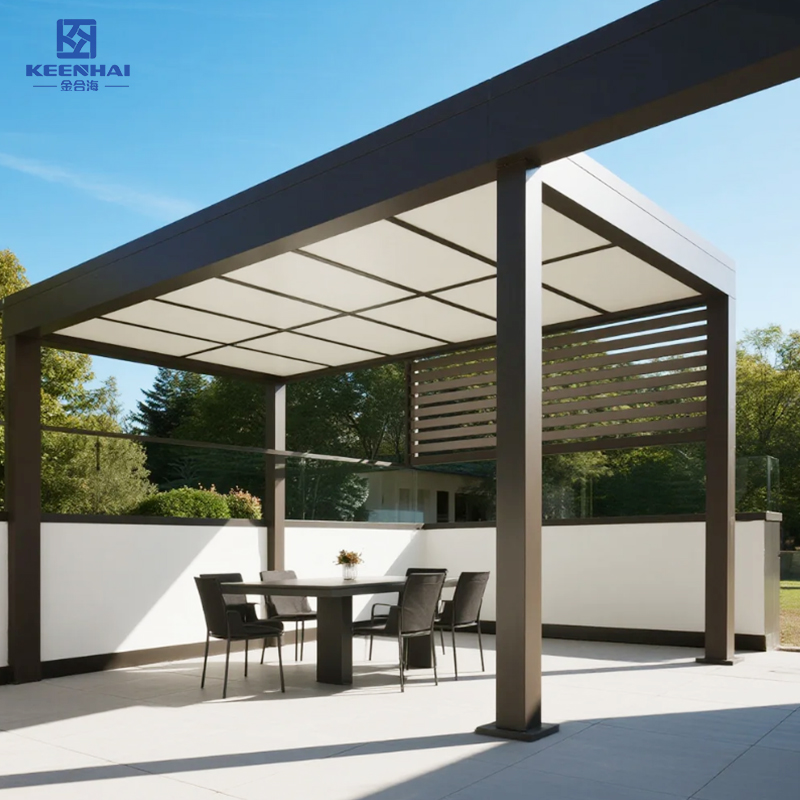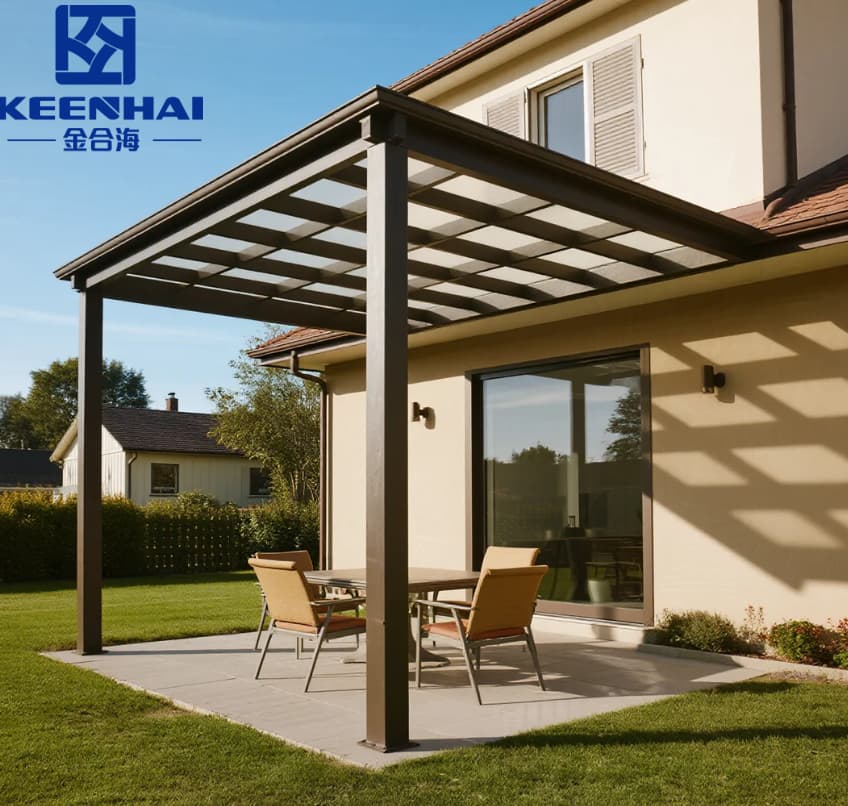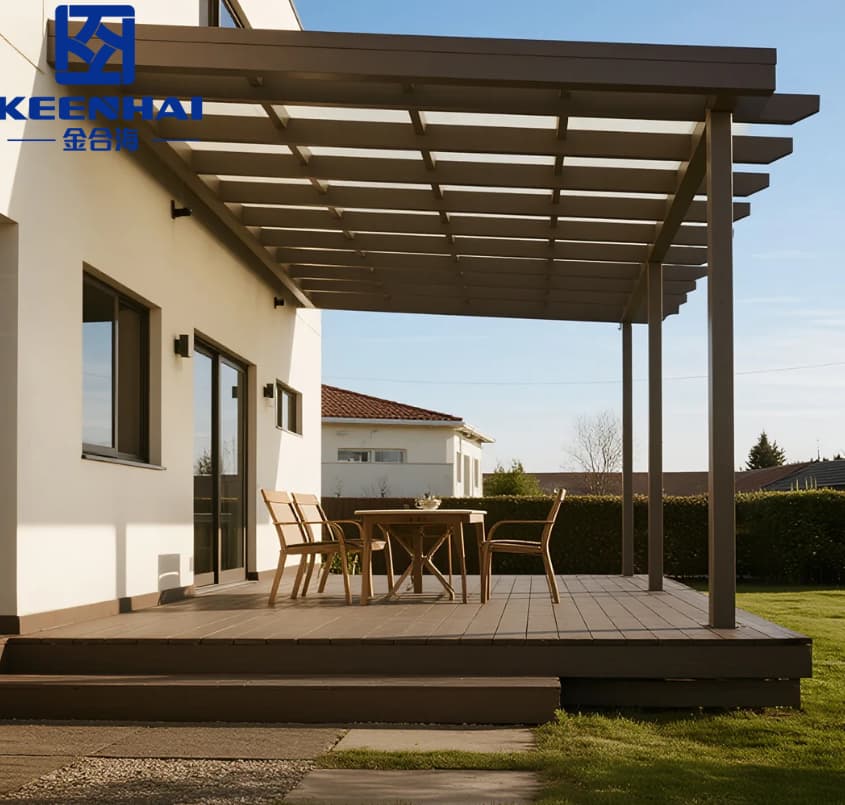
Material Comparison
1.1 Wood Gazebo Types and Characteristics
Wood gazebos come in several popular types, including cedar, redwood, and pressure-treated pine. Cedar is naturally resistant to rot and insects, offering a rich, warm color that ages beautifully over time. Redwood is durable and highly stable, with a smooth texture that is ideal for fine craftsmanship. Pressure-treated pine is more budget-friendly and widely available, though it requires regular sealing to maintain longevity. Many homeowners choose wood gazebos for their classic aesthetic and natural charm, making them a centerpiece in gardens or backyards.
1.2 Aluminum Gazebo Types and Characteristics
Aluminum gazebos are lightweight, strong, and practically maintenance-free. Standard Aluminum Gazebo designs are ideal for patios, while modular or prefab variations allow for quick installation. Aluminum resists rust, warping, and insect damage, making it a smart choice in humid or coastal environments. Many modern outdoor spaces favor aluminum for its sleek, contemporary look. For instance, homeowners often place aluminum gazebos near pools or outdoor dining areas, enjoying the balance of durability and style without constant upkeep.
1.3 Strength and Durability Comparison
| Feature | Wood Gazebo | Aluminum Gazebo |
|---|---|---|
| Weight | Heavy, needs solid base | Lightweight, easy to relocate |
| Lifespan | 10–20 years with regular maintenance | 20+ years, minimal upkeep |
| Weather Resistance | Prone to rot, warping, insect damage | Rustproof, termite-resistant, withstands harsh weather |
| Maintenance | Annual sealing or staining required | Occasional cleaning only |
| Installation | Usually needs professional help | Prefab models allow DIY assembly |
In practical terms, aluminum gazebos generally outperform wood in longevity and low maintenance, especially in climates with frequent rain or high humidity. While wood offers warmth and a natural feel, aluminum delivers reliability and convenience, making it a go-to choice for homeowners who want a hassle-free outdoor structure.

Cost Analysis
2.1 Initial Purchase Price of Wood vs Aluminum Gazebos
When it comes to upfront costs, wood gazebos usually range between $2,500 and $6,000, depending on the type of wood, size, and design complexity. Cedar and redwood models are on the higher end due to their durability and natural beauty. Pressure-treated pine is cheaper but requires more frequent maintenance, which can add indirect costs over time.
Aluminum gazebos, while slightly higher in base price—typically $3,000 to $7,000—offer the advantage of being maintenance-free for years. This makes them a smart choice for homeowners who want a durable, long-lasting structure without ongoing upkeep. For example, an aluminum gazebo installed on a poolside patio may cost more initially but saves money on sealing, painting, and repair compared to a wooden counterpart.
2.2 Long-Term Value and Investment
When evaluating long-term value, consider both durability and maintenance requirements. Aluminum structures hold up against extreme weather, resist pests, and rarely need replacement. Wood gazebos, although charming and visually appealing, often incur costs for annual sealing, staining, and occasional repairs.
| Aspect | Wood Gazebo | Aluminum Gazebo |
|---|---|---|
| Lifespan | 10–20 years with maintenance | 20+ years with minimal upkeep |
| Maintenance Costs | $100–$300 per year for sealing and repairs | $0–$50 per year for cleaning |
| Replacement/Upgrade | May need partial replacement after 10–15 years | Rarely requires replacement |
In practical terms, the initial investment for aluminum pays off over time. For instance, homeowners who choose aluminum for a backyard dining area often find that the structure looks pristine for over a decade, while wood models in the same environment may show signs of wear and require frequent touch-ups.
2.3 Installation Expenses
Installing a wood gazebo often involves 3 steps:
-
Preparing a solid, level foundation, which may require concrete work.
-
Assembling the wooden frame, which can be labor-intensive due to the weight of the materials.
-
Finishing touches, including sealing, staining, or painting to ensure weather protection.
Aluminum gazebos simplify installation considerably:
-
Many prefab models arrive with pre-drilled parts and easy-to-follow instructions.
-
Lightweight aluminum panels reduce labor time and effort.
-
Finishing is minimal—usually a quick wash or inspection is enough to keep it looking new.
In real-life applications, a homeowner installing a prefab aluminum gazebo on a patio deck may complete the project in a single weekend, whereas a comparable wood gazebo could take several days with at least two people working. This difference not only saves time but also reduces labor costs.

Maintenance and Longevity
3.1 Cleaning and Upkeep Requirements for Wood Gazebos
Wood gazebos, while visually warm and inviting, demand consistent upkeep to maintain their appearance and structural integrity. Typically, owners should:
-
Inspect the structure annually for signs of rot, cracks, or insect damage.
-
Apply a high-quality sealant or wood preservative every 12 months to protect against moisture and UV exposure.
-
Clean the surfaces regularly with a mild detergent and soft brush to prevent mold or mildew buildup.
In coastal or humid areas, skipping these steps can shorten the lifespan significantly, turning a beautiful cedar gazebo into a maintenance headache. For example, backyard pergolas in tropical climates often need more frequent staining or sealing compared to those in dry, temperate regions.
3.2 Cleaning and Upkeep Requirements for Aluminum Gazebos
Aluminum gazebos are far more low-maintenance. A simple rinse or wipe-down a few times a year keeps the structure looking new. For homeowners who want modern, hassle-free solutions, a prefab aluminum pergola or a sleek modern aluminum gazebo can be installed with minimal upkeep. These structures resist rust, warping, and termite damage, which is especially valuable in areas with frequent rain or high humidity. Many people place them on patios or poolside areas where exposure to the elements is constant—yet the maintenance remains straightforward.
3.3 Lifespan Comparison Under Different Weather Conditions
| Weather Condition | Wood Gazebo Lifespan | Aluminum Gazebo Lifespan |
|---|---|---|
| Dry/Temperate | 15–20 years with regular maintenance | 20+ years, low maintenance |
| Humid/Coastal | 8–12 years without diligent care | 20+ years, minimal upkeep |
| Rainy/Storm-Prone | 10–15 years, susceptible to warping | 20+ years, resists corrosion |
| Snow/Icy | 12–18 years, may need structural reinforcement | 20+ years, lightweight but strong |
In practice, aluminum gazebos consistently outlast wood models in challenging climates. Homeowners often report that aluminum waterproof pergolas remain structurally sound and visually appealing even after years of heavy rain, while wood gazebos require more frequent repairs and preventative treatments. This durability makes aluminum a reliable long-term choice for patios, gardens, and outdoor entertainment areas.

Aesthetic and Design Considerations
4.1 Style Options for Wood Gazebos
Wood gazebos offer a timeless, natural look that blends seamlessly into garden and backyard settings. Popular styles include:
-
Traditional Victorian – Featuring decorative trim, lattice panels, and ornate detailing, ideal for classic gardens or historic homes.
-
Rustic Cabin – Made from rough-hewn timber or reclaimed wood, perfect for woodland backyards or natural landscapes.
-
Modern Minimalist – Clean lines and simple wooden frames that complement contemporary outdoor spaces.
Wood gazebos are versatile in design and can be painted or stained in various colors to match existing landscaping. Many homeowners place them on lawns or near flower beds to create an inviting, shaded seating area, often incorporating hanging planters or fairy lights to enhance the atmosphere.
4.2 Style Options for Aluminum Gazebos
Aluminum gazebos cater to homeowners looking for sleek, modern aesthetics with low maintenance. Key styles include:
-
Contemporary Flat-Top – Straight lines, metal frames, and minimal decoration for a clean, urban look.
-
Louvered Roof Designs – Adjustable slats provide both shade and ventilation, ideal for patios or poolside decks.
-
Pergola-Style Aluminum Gazebos – Open or semi-covered designs that combine structural strength with a modern visual appeal.
These structures often come in powder-coated finishes in neutral tones like black, grey, or white, which resist fading over time. Placing an aluminum gazebo on a rooftop terrace or alongside a modern pool can dramatically enhance the outdoor space while keeping upkeep minimal.
4.3 Customization and Decorative Choices
| Feature | Wood Gazebo | Aluminum Gazebo |
|---|---|---|
| Paint/Finish | Can be painted or stained any color | Powder-coated finishes, limited palette |
| Decorative Accents | Carved panels, latticework, hanging planters | LED lighting, retractable awnings, modern trims |
| Roof Options | Shingles, cedar shakes, thatch | Louvered panels, waterproof covers, flat metal roofs |
| Flexibility | Can be remodeled or modified over time | Modular panels allow reconfiguration but less structural alteration |
Customization in both wood and aluminum gazebos allows homeowners to tailor their outdoor structure to personal tastes and functional needs. For example, a backyard dining area might feature a wood gazebo with hanging lanterns for a cozy, intimate setting, while a poolside modern aluminum pergola could include a retractable louvered roof to provide both sun and rain protection. Combining decorative elements with practical features ensures the gazebo enhances both the visual appeal and usability of the space.

Practical Suitability and Use Cases
5.1 Best Scenarios for Wood Gazebos
Wood gazebos excel in traditional garden or backyard settings where natural beauty and warmth are a priority. Ideal scenarios include:
-
Flower gardens or backyard lawns – The natural wood tones complement greenery and floral arrangements.
-
Cozy outdoor seating areas – Adding benches or hammocks creates a comfortable retreat.
-
Rustic or vintage-themed landscapes – Decorative carvings and latticework enhance the classic charm.
For example, a cedar wood gazebo placed near a rose garden can become a focal point for outdoor gatherings, while also providing shade and a relaxing spot to enjoy the scenery. Wood’s natural texture and finish allow homeowners to integrate lighting, climbing plants, or seasonal decorations seamlessly.
5.2 Best Scenarios for Aluminum Gazebos
Aluminum gazebos are ideal for modern, low-maintenance outdoor spaces, and they perform exceptionally well in challenging weather conditions. Common use cases include:
-
Patios and decks – Lightweight aluminum structures are easy to install and don’t require heavy foundations.
-
Poolside or coastal areas – Resistant to rust, warping, and corrosion, making them perfect for humid climates.
-
Rooftop terraces or commercial spaces – Sleek designs fit contemporary architecture and urban environments.
Homeowners often choose an Aluminum pergola house for backyard dining or poolside lounging because it provides both shelter and a modern aesthetic. Modular designs allow for quick installation and flexible layout adjustments, making aluminum gazebos a practical solution for diverse outdoor settings.
5.3 Climate and Environment Considerations
| Factor | Wood Gazebo | Aluminum Gazebo |
|---|---|---|
| Humidity & Rain | Susceptible to rot and warping; requires frequent sealing | Rustproof and low maintenance; ideal for wet climates |
| Coastal/Salty Air | Prone to corrosion over time | Highly resistant; retains structure and finish |
| Snow & Ice | Needs reinforced frame for heavy loads | Lightweight but strong; withstands snow accumulation |
| Wind Resistance | Heavy and stable but can suffer damage if not anchored | Lightweight, easy to secure; modular panels reduce wind stress |
In addition to practical durability, aluminum gazebos offer long-term value for homeowners who want minimal upkeep without sacrificing style. Choosing the right structure depends on the environment and intended use. For instance, urban homeowners may prefer aluminum for rooftop terraces, while suburban families might favor wood to blend with landscaped backyards. Ultimately, for high-quality aluminum solutions and a variety of customizable options, the keenhaipergola brand provides reliable products that fit different outdoor scenarios.
